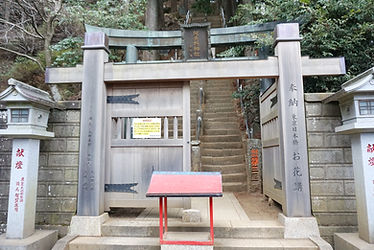普通の外にいくつかの著名な品質を持っている、と畏敬の念を起こさせるあるいかなるビーイングは、カミと呼ばれています。

大山阿夫利神社
Oyama Afuri Shrine
Nearest station: Isehara Line: Odakyu (OH36)
Kanagawa-ken, Isehara-shi, Oyama 355 神奈川県伊勢原市大山355 March 5, 2023
Enshrined Kami:
Main
Ōyamazumi-Okami 大山祇大神
Takaokami-no-kami 高龗神
Ooikazuchi-Kami 大雷神
From Merged Shrines
In-ground Shrines:
Sorei-Sha 祖霊社
Oiwake-Sha 追分社
Tenman Gu 天満宮
Sengen Shrine 浅間神社
Katsukaishu Shrine 勝海舟神社
Nenomoto Shrine 根之元神社
Annual Festival: July 27
Divine Favours (御利益 Goriyaku)
Family well-being (家内安全, Kanai Anzen)
Business prosperity (商売繁盛, Shobai Kanjo)
Traffic safety (交通安全, Kotsu Anzen)
A healthy body (身体健全,Shintai Kenzen)
Realization of one's earnest wishes (心願成就, Shingan Joju)
Success in an entrance exam (合格祈願,Gokaku Kigan)
Success in scholarship (学業成就, Gakugyo Joju)
Company safety (社内安全,Shanai Anzen)
Prosperity of the company (社運隆盛, Shaun Ryusei)
Safety of construction work (工事安全, Koji Anzen)
Prayer for certain success (祈必勝, Ki Hissho)
Recovery from illness (病気平癒, Byoki Heiyu)
I visited this Afuri shrine as part of a group visit organised and led by Alice Gordenker. For which, many thanks to Alice.
The shrine is one of the 13 listed in the Sagami Province section of the Engi-shiki compiled in 927. Its official name is Afuri Jinja but its history and culture are so closely entwined with Mt Oyama and Oyama Temple that referring to it as Oyama Afuri Jinja is almost inescapable. Its main hall (honden) sits on the peak of Mt Oyama at an elevation of 1,251m., while the Shimo-Sha, (lower shrine) which includes the haiden (prayer hall), is halfway down the mountain at 696m. and is accessible by cable car. A bus from Isehara Station goes to the Cable Car bus stop, but, beware: although the walk from the bus stop to the cable car terminus is said to take 15 min. it is uphill all the way, there are 363 stone steps, and 30 min. is probably more realistic for most people. For those brave souls wishing to walk to the haiden rather than take the cable car there are a further 1,234 stone steps.

The lower shrine is said to have been founded in 97 BC during the reign of the 10th (legendary) emperor, Sujin. The current haiden dates to 1977. Its predecessor, a wooden hall which was built in 1910, was relocated to the north of the new haiden.
The shrine on the mountain peak was established in 755. An earthquake devastated the entire area in 879 and the shrine was rebuilt in 890. Restoration work was carried out in 1641, and in 1693 the shrine was renovated on the orders of the fifth Tokugawa Shogun, Tsunayoshi. In 1710 the shrine was burnt down and reconstructed the following year on the orders of the eight Tokugawa Shogun, Yoshimune. It was burnt down again in 1771 and rebuilt in 1778. Further renovation work is carried out in 1802.
The shrine was originally known as Sekison-sha and the enshrined Kami was Sekison Dai Kongen (石尊大権現). The name Sekison derives from the fact that a miraculous rock (reiseki 霊石) was worshipped at the mountain peak. Two subordinate shrines were also established, the Oku-sha (rear shrine 奥社) and Mae-sha (front shrine前社); the enshrined Kami were respectively Daitengu and Kotengu.
With the advent of the Meiji Restoration and the enactment of the Shinbutsu Bunri order, the Oyama Temple site was designated as the new site for the Afuri Jinja Shimo-sha. The Buddhist deity Sekison Dai Kongen was replaced by Ōyamazumi-Okami, and Daitengu and Kotengu by Takaokami--kami and Ooikazuchi-Kami. After being burnt down in a fire the main hall was rebuilt in 1880. Its shintai is a huge blue rock said to lie below the shrine.
If Minatogawa Jinja is all about Samurai loyalty then Afura Jinja could well be described as being all about pilgrimage. According to the shrine’s home page about 200,000 pilgrims, mostly from Edo, visited the Oyama site each year in the mid-eighteenth century; this at a time when Edo’s population was about one million. A much earlier pilgrim to the shrine, and certaiinly one of the most famous, was Minamoto Yoritomo, who is said to have started the custom of Osame-dachi (donating swords, 納太刀). While it seems that Minamoto essentially just dedicated his sword, among other things, to the shrine, Osame-dachi evolved into the custom of people donating usually wooden swords, on one side of which were engraved both the divine wishes being sought and the names of Sekison Dai Kongen, Daitengu and Kotengu; on the other the donor’s name and the pilgrim group to which he belonged were engraved. The custom further evolved into groups of several people carrying very large swords, up to four m in length, from their hometowns to the shrine. A photo of one such sword stored in the basement of the haiden can be seen here.
Mt Fuji is clearly visible from Mt Oyama, they are 46.5km apart as the crow flies, and pilgrimages to the two, including Afuri Jinja, were often combined. There is a Sengen Jinja in the shrine grounds and the goddess of this shrine, Konohanasakuya-hime, is also the Kami of Mt. Fuji. Her father is Ōyamazumi-Okami, the main deity of Afuri Jinja, and for this reason shrine officials claim, and I am not sure if this is tongue in cheek or not, that Mt Oyama is spiritually more important than Mt Fuji.
Click to expand image
















Monuntaintop Afuri Jinja Hai-den Hon-sha Oku-sha
(Courtesy wikimedia.org)
















%20(1).jpg)